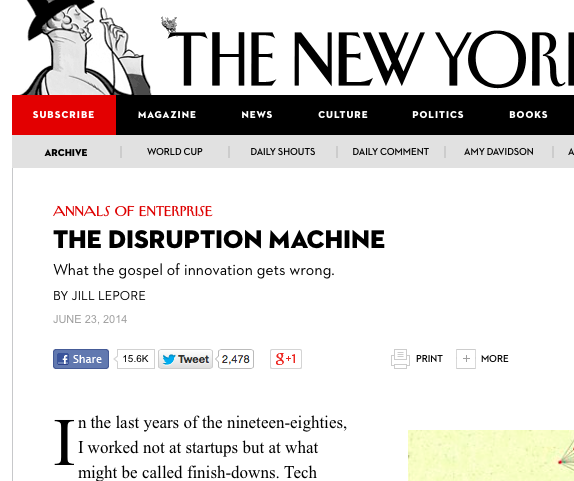Harvard business school professor stunned by Jill Lepore's attack on his book in the New Yorker
When the New Yorker this week published Harvard historian Jill Lepore’s sharply written dismissal of “disruptive innovation,” it was an attack on one of the most widely cited and celebrated ideas in modern business. As first laid out by its creator, Harvard Business School professor Clayton Christensen, in his 1997 book, The Innovator’s Dilemma, the theory holds that established companies, acting rationally and carefully to stay on top, leave themselves vulnerable to upstarts who find ways to do things more cheaply, often with a new technology. The book became a bestseller in 1999, at the height of the dot-com boom, as it seemed to describe the threat e-commerce posed to established companies. Christensen expanded on it in a series of sequels, including The Innovator’s Solution, The Innovator’s Prescription, about health care, and Disrupting Class, about education.
Disruption, as Lepore notes, has since become an all-purpose rallying cry, not only in Silicon Valley—though especially there—but in boardrooms everywhere. “It’s a theory of history founded on a profound anxiety about financial collapse, an apocalyptic fear of global devastation, and shaky evidence,” she writes. In the article, she accuses Christensen of poor scholarship (handpicking case studies that conform to his theory); misreading history (some companies he casts as doomed continued to perform well); and myopia (missing, for example, the role unions played in the collapse of U.S. Steel). Lepore also notes that a fund manager who used Christensen’s theory as an investment strategy lost even more than most in the Nasdaq implosion of 2000.
Christensen hasn’t responded in writing to the essay, but when I reached him by phone on Thursday afternoon, it was clear he’d been thinking about it. Consistently described by those who know him as a generous and thoughtful and upbeat person, he is also capable of fury. “Keep asking me questions,” he said, “it’s helping me.”
What did you think of the essay?
Well, in the first two or three pages, it seems that her motivation is to try to rein in this almost random use of the word “disruption.” The word is used to justify whatever anybody—an entrepreneur or a college student—wants to do. And as I read that, I was delighted that somebody with her standing would join me in trying to bring discipline and understanding around a very useful theory. I’ve been trying to do it for 20 years.
And then in a stunning reversal, she starts instead to try to discredit Clay Christensen, in a really mean way. And mean is fine, but in order to discredit me, Jill had to break all of the rules of scholarship that she accused me of breaking—in just egregious ways, truly egregious ways. In fact, every one—every one—of those points that she attempted to make [about The Innovator’s Dilemma] has been addressed in a subsequent book or article. Every one! And if she was truly a scholar as she pretends, she would have read [those]. I hope you can understand why I am mad that a woman of her stature could perform such a criminal act of dishonesty—at Harvard, of all places....
